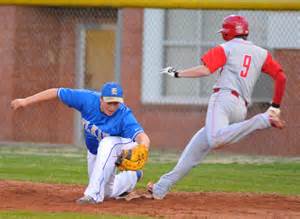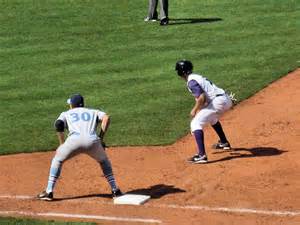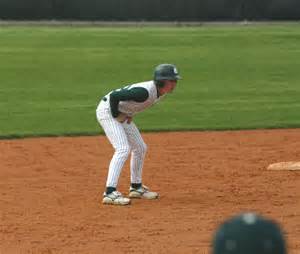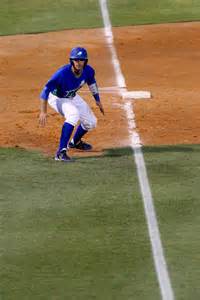Baseball Training-Base Running
Let's talk baseball training-base running.
Running… Man has been running for thousands (1000s) of years. Running the bases, a little over a 100 years. Just because you know how to run doesn’t mean you know how to run the bases in baseball and that’s a huge part of the game.
Let’s look at some running drills, somewhat basic, that will teach you the general rules of base running.
Rule 1. Get on base. Practice hitting an imaginary infield ground ball by swinging a bat, then explode out of the batters’ box. Run a straight line, shortest distance between 2 points is a straight line, doesn’t matter if it is inside or outside the foul line.
Never break stride and hit the front of the base with your foot, as you reach the front of the base before the back portion.
Never slow down as you approach the base. First base is the only base you can legally run past and not be put out.
Once past the base slow down, stutter stepping or widen your feet, turn to your right and walk back to the base. Unless you hear your coach yelling or actually see an overthrow, never make a move toward second base or you can be tagged out.

baseball training-base running / Never Slow Down
Rule 2. Always be thinking 2 (double). Again, swinging the bat imagine you have hit a sinking line drive into the outfield that you know will drop in for a hit. Explode out of the batters’ box and start running towards first base in a straight line, however @ 2/3 of the way down the baseline, swing slightly to your right towards the dugout in a backwards C motion.
This will slingshot you towards first base, which you will hit with your right foot on the inside portion of the base pushing off in a straight line towards second base. If the ball is cleanly fielded, slam on the brakes and return to first base. If the ball is bobbled, continue on to second base, be sure to slide into second as it will be normally a close play.
Rule 3. Double Practice turning a base hit into a double. Practice the swing and hitting the inside of first base.
Rule 4. Triple Practice exactly as before except practice the swings and the proper hitting of the inside of both first and second base.
Remember this: Never make the First or Last Out at third base. Most of the time you can score from second base on a hit as easily as from 3rd base. A lead-off double gives the team 3 chances to drive you in. A 2 out double gives the team a chance to drive you in with a hit.

baseball training-base running./ Lead Off 1st
Lead Offs: First Base
1. When looking to the coach for the signal always be in contact with the base. Why? If you are concentrating on the coach, you are not watching the pitcher, which means a snap throw over to first could get you out before getting back to the base.
2. Take your lead in small shuffle steps, never leaving the ground or crossing your feet in order to move forward. Why? If you are off the ground you can’t reverse direction until you make contact back to the ground. If your feet are crossed, you must finish the cross, then uncross then return to the base. All these unnecessary movements take time and time is one thing in short supply.
3. A good secondary lead is very important. Remember to slightly stagger your feet, right rear foot slightly behind the front foot. This offers a streamlined cross over step when stealing a base. Once you determine the pitcher is throwing home, take 2 to 3 large shuffle strides towards second base. Never take your eye off the baseball. There are catchers who will throw behind the runner nailing you lazily returning to first base.

baseball training-base running./ Lead Off 2nd
Lead Offs: Second Base:
1. Leading off second base is a 2 person job. You are responsible for keeping track of where the second baseman is located, while the third base coach watches the shortstop’s actions.
2. We talked about running in straight lines. Lead offs of second base tend to bend those rules. As a runner you should lead off at least 2 steps behind the imaginary baseline as there is a two-fold reason for this.
a. It gives you a running line in which you can hit third base on the inside portion and take a straight line to home plate.
b. You can begin motion by creeping towards the pitcher in the set position, and lessen your distance to third base.
3. Always be wary and keen on 2 issues. Make sure you don’t stray too far off second base on your secondary lead that you can’t get back safely, and watch for a pitcher/catcher’s routine. If you spot a flaw it could help you steal third base. Saying that… Never get caught trying to steal third base with no outs or 2 outs.

baseball training-base running./ Lead off 3rd
Lead Offs: Third Base:
1. Always lead off in Foul Territory and return to third in Fair territory, which makes a throw from the catcher harder to make.
2. It’s always important to know the situation, but particularly important while at 3rd base. Are the infielders playing back or in? What place hitter is at bat? How many outs? These all play a crucial part in your decision making process.
3. Freeze on line-drive hits. You never want to be doubled up on a line drive. If it is caught, scurry back to the base. If it gets through, jog home.
4. Always go back to the base and tag up on any fly ball with less than 2 outs anticipating on tagging up and scoring after the catch.
Anticipation Drill:
Station a runner on each base, 1st, 2nd & 3rd, & home plate telling them to pretend they are the only runner/hitter on base.
Tell them a particular situation: such as 1 out. Then hit a fly ball to the right outfield and see how each runner reacts.
1. The runners on 2nd and 3rd should automatically go back to their base to tag up.
2. The runner on 1st should go half way and see what happens.
3. The batter should run through first base.
You can run as many scenarios as you want changing the situation which could affect the runners’ decision. This is a great way of pre-programming runners’ instincts, which results in instant reaction time.
Baseball Training - Base Running to Running the Bases

New! Comments
Have your say about what you just read! Leave me a comment in the box below.